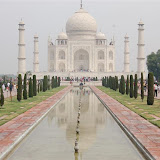i am finishing a book titled “snooping”. yes, i have some pretty strange reading habits. “profiling” is waiting to be finished, but this book happened to present itself at a time when the question of how to understand people better, and the need to sit in a quiet place and read about something not expressly work related intersected perfectly. the basic idea in the book is that you can read a person based on the spaces they construct for themselves, or the residue they leave behind in the spaces they inhabit.
the book focuses on the bedrooms, bathrooms, living rooms, offices, homepages, blog spaces, music or book collections people create and share with others. there is a differentiation between public and private spaces. there is the idea that people may construct false images of themselves, but that clues of the deeper self can be gained by gaining access to these “personalized” indicators of themselves.
there is really nothing earth shattering in this book, an observant person might pick up on much of it without knowing why. this is actually discussed and is part of the research that lead to the book. what was interesting was that people do inherently know they are being watched. i have noticed that most malaysians do not personalize their workspaces for example; i have wondered if this is because they see the space as transient and temporary, or if they simply do not feel comfortable allowing people at work to have a view into their inner selves. this is not everyone; but one in hundred has a toy fish tank on his desk; a shockingly low value for a guy with a fathers-day “family guy” in his own office.
but if malaysians are so restrained in their display of personality, if they are careful not to allow others do see the clues to the true inside, where can one look. what was needed was a public space that also has a high degree of privacy to it. where are people comfortable being themselves, but are also comfortable sharing the space with others?
the answer i came to, one surprisingly not in “snooping”, is a person’s car. this is a space we spend a good deal of individual time in; we create it in the image of what makes us comfortable. the car itself many times is an indication of the person we see ourselves as. our personal worldview is wrapped into our choice of hummer over electric car, or mini-van over roadster.
i have a friend who drives a car affectionately known as the cockroach. the name is derived from the mascot insect that seems to perpetually inhabit the mobile storage space that the car represents. clothes, makeup, luggage and random possessions of life are haphazardly layered across the passenger and boot spaces. this car reflects the nomadic lifestyle of its owner as much as it results from it. the fact the car was driven for months without a road-tax sticker, and that the driver drove for months without a license, are both strong indicators of the owners deeper random personality. a personality the car with its flotsam and jetsam contents clearly indicate.
i have also considered the cars i drive. i have two distinct sets. i have a car in the US which i love. i only see it for 3 or 4 weeks a year, but knowing that it is there for me when i go home is a reassuring feeling. when i go to my son’s soccer game, and realize it is much colder than i prepared for, i can reach into the trunk space, and pull out a warm jacket, a hat and even a sweater for my son. my chair for the game is no longer there, but if i am lucky it is waiting for me on the side of the field. my family sports wagon, with 4 wheel drive to climb slippery hills and traction control for the commutes during blizzards represents me. i have finished paying for it. it is mine and i love it; even if someone else gets to drive it while i am unable to snuggle into the heated leather seats,
while in malaysia, i drive a perdana. this is the top of the line local car, and sadly it would never sell outside the country. definitely not at the price it is sold for locally. somehow, malaysians have been convinced cars are meant to cost three times more than they do in the developed world. low quality at an expensive price is not a way to attack a world market. it may temporarily work in a closed economy, but to compete you need a price point that it tied to your value. this concept has not yet been baked into malaysia.
the lack of quality does mean that i change cars every few months. having no emotional tie beyond a rental agreement, the first sign of issue has me calling for a new less trouble prone kereta. the issues are forgotten as soon as i can get the new seat adjusted and the radio stations set. the fact that i use an ipod in the car is largely driven by this ability to switch perdana’s in the time it takes two people to look through a few pockets or under a seat for items they don’t want to have left behind.
i have wondered what this easy mobility here, compared to the comfort with my of my cross-country in the us tells others about me. i see newer, smaller, sexier models of sports wagons here, or the xc-60 i just saw at schiphol which grabbed my eye but gave me no chance to sit and feel the seats. i know while i am here, the cost of buying a car may never be worth it to me, the price is artificially inflated and having the wheel on the wrong side means it cannot be easily brought to left hand drive countries.
reading people by their possessions and their spaces does come with challenges. when someone tells you they love to cook and to read, it might be hard to gauge without walking around their house to find no bookselves and a singular copy of “betty crooker” their grandmother gave them when they went to college. but walking someone who has just told you that their three children are the most important thing in their lives; and finding them driving a two-seater sports car is an indication of who they truly are.
look for the things people put in auto-mode, they can give you a deeper view.
Saturday, December 13, 2008
Subscribe to:
Post Comments (Atom)











No comments:
Post a Comment